Sometimes it’s challenging to find activities for your dog in the summer months when temperatures can be hot and uncomfortable.
That being said, we still manage to be active with our dogs all summer, so we compiled our favorite summer activities, toys, games and treat recipes for dogs!
Please add your own ideas for summer fun for dogs in the comments section at the end of the article!
-Julia & Barbara

10 Things to Do With Your Dog This Summer
Topics covered in this post:
- Swimming tips for dogs – safety & training
- Best water toys for dogs
- Summer games and puzzles for dogs
- Visiting pet friendly stores
- Frozen summer treats for dogs!
- Visiting breweries & patios with your dog
- Attending sports events & festivals
- Summer hiking with dogs
- Camping with your dog
- Summer vacation with your dog
- General tips for helping shy dogs in public
1. Take your dog swimming!
The best way for a dog to beat the heat in summer? Get wet!
Swimming is a great way to get outside and provide your dog with a stimulating experience without worrying about him overheating.
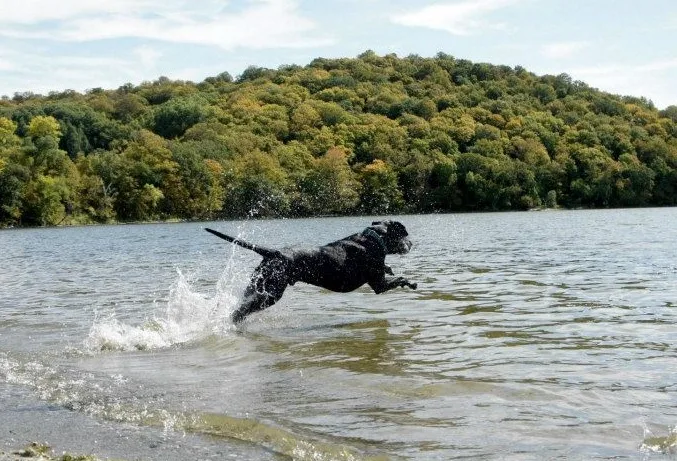
We are using the term “swimming” very broadly here. As Julia has written before, her dog Baxter does not swim. But on a hot day when they’re around water, he wades in unhesitatingly, even laying down in a ditch to cool down during a walk last summer.
How to get your dog used to water
If your dog is also not a swimmer, don’t force him to do the doggie paddle. Likewise, if your dog has not been around water before or doesn’t like water, don’t start by throwing him in the deep end (figuratively or literally)!
- Take walks near water to get your dog used to the smells and sounds.
- Find a dog friendly beach that’s not too busy.
- Choose a spot where the water is calm so that there aren’t waves or splashes to surprise your dog.
- Walk into the water yourself and encourage your dog to follow you.
- Once your dog ventures into the water, let him choose how deep he goes.
Visit the dog beach!
Many public beaches do not allow dogs, and it can be difficult to find designated dog beaches. Facebook groups or local dog walkers can be good sources to find the best swimming spots.
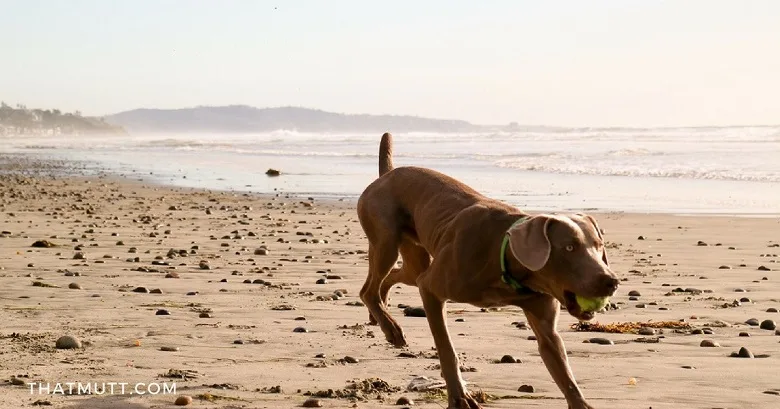
Once you find a dog beach that you like, take care of it. Be considerate of other humans and dogs by picking up waste and supervising your dog carefully.
Alternatives to dog beaches include backyard pools, a baby pool, or even the hose or a sprinkler, if your dog is comfortable being sprayed.
Finally, if your dog seems to love the water, you might even consider training him in the sport of dog dock diving!
How to keep your dog safe when swimming:
Stay away from currents. Avoid big waves, undertows, rapids or other swift moving water that can knock your dog over or carry him away from shore. Be especially careful if your dog is obsessed with fetching a toy.
Monitor your dog carefully. Some dogs become very excited around water. If other dogs are around, make sure your dog doesn’t overwhelm them. Drowning is also a concern if your dog gets tired while swimming. Watch closely to keep your dog safe, especially if he’s a senior or a puppy.
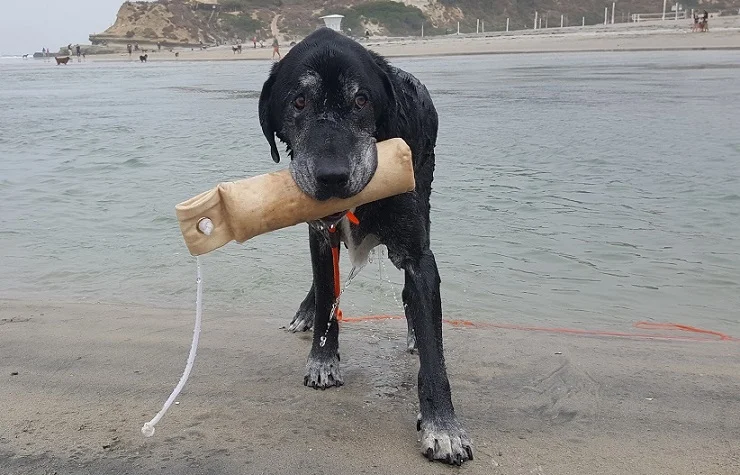
Have an exit plan. Certain swimming areas are easier for a dog to get into than out of (a pool is a good example). Plan how you’re going to get your dog out and when he seems ready, help him out promptly.
Combat chlorine. While chlorine levels in pools are usually safe for dogs, the water is still treated with chemicals. Rinse your dog with clean water after swimming in a pool and make sure he doesn’t drink the chlorinated water.
Ward off ear infections. Water and dampness can cause ear infections in some dogs. Dry your dog’s ears with a towel or cotton balls after swimming.
The best dog swimming gear
Life jacket – Life vests add an extra level of safety for your dog, particularly if you bring him along while boating or paddling. Many life jackets come with a handle on the back for lifting your dog from the water.
Life jackets come at various prices with many different features. Choose what best meets your needs and, most importantly, make sure you get the correct size for your dog.
Long leash – A long leash can ensure that your dog doesn’t go too deep into the water or too far from you while swimming. At the same time, a leash can give your dog a fairly large range, allowing him to swim (almost) freely.
Waterproof collar – Water can be hard on certain collar materials, like leather. Other materials absorb the water, leaving your dog with a wet and potentially smelly collar. If you’re swimming frequently, a waterproof collar can make your outings more enjoyable.
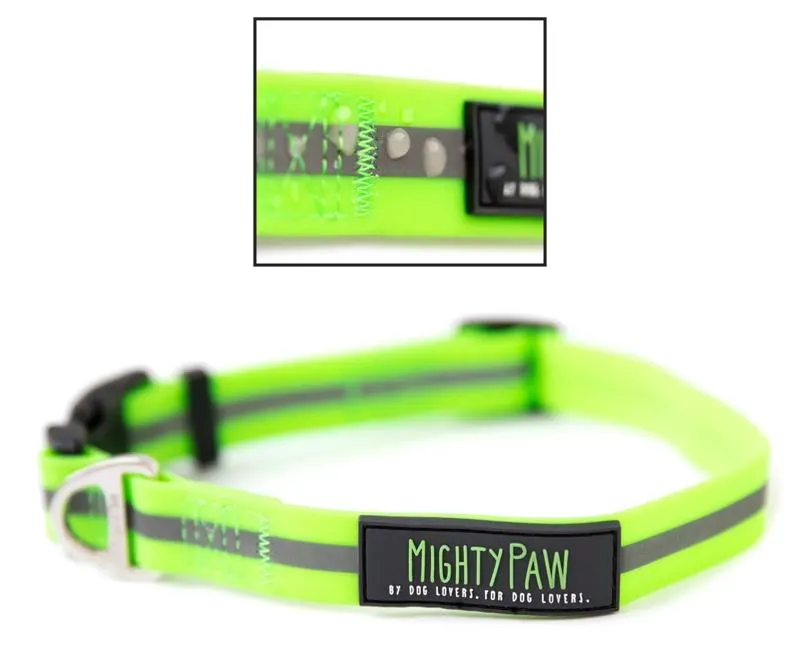
Towel – Dogs are famous for their signature shake after exiting the water, but they will still be wet after swimming. Before your dog gets into your car or enters your house, you will likely appreciate having a towel to dry him off.
2. Buy your dog some water toys!
Let’s stay with the topic of getting your dog wet for a little while longer! If your pup loves being in and around water, specific water toys can add a lot of extra fun.
Best water toys for dogs
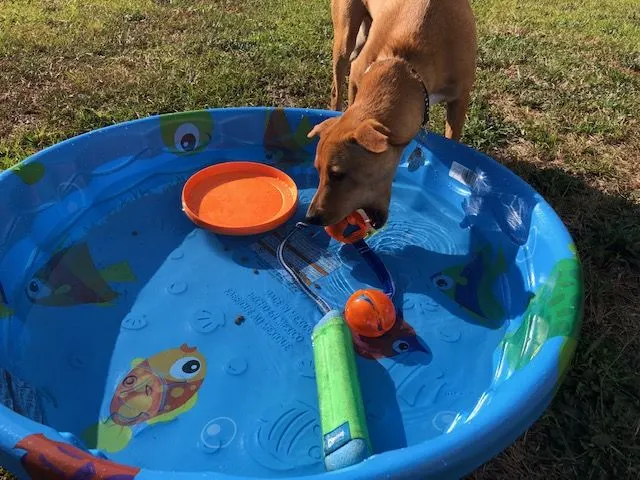
While they’re designed to float in water and come in extra bright colors that make locating them a breeze, they also make great toys for playtime on land.
That being said, our three favorite water toy picks are:
Amphibious bumper by Chuckit!
The Amphibious bumper is made of soft, but durable memory foam that’s unsinkable and comes in two different sizes (small and medium) and in 2 bright colors (blue/green and orange/blue).
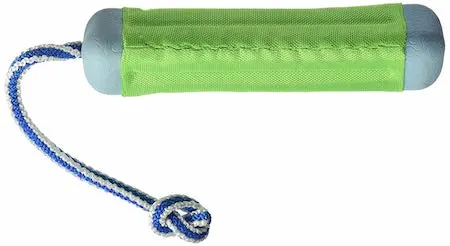
It’s attached to a cord which makes it perfect for games of tug-o-war and fetch in the water. It’s designed for medium and large breeds.
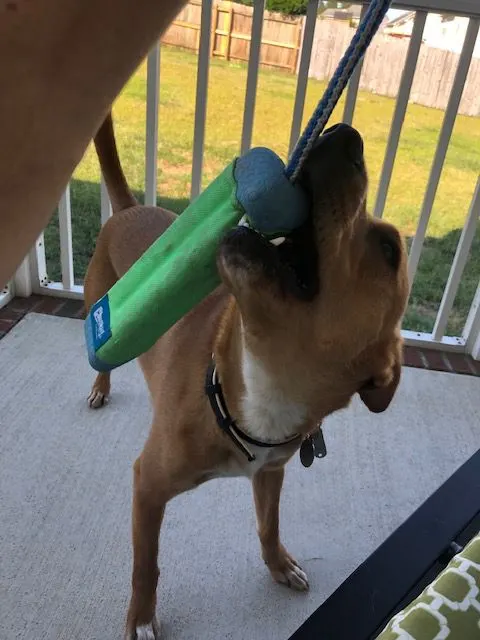
Zogoflex Zisc by West Paw
The Zogoflex Zisc is a floating frisbee that’s available in 2 sizes (small: 6.5” in diameter, and large: 8.5” in diameter) and 6 different colors (aqua, glow, granny smith, ruby, tangerine, and black).
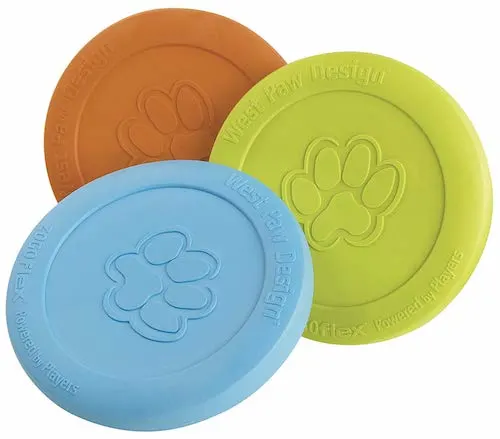
It’s made of West Paw’s Zogoflex material which is bendable and soft on a dog’s mouth, yet durable. It’s great for games of fetch in the water. It’s BPA- and phtalate-free and can be cleaned on the top rack in the dishwasher.
Bonus: It’s made in Montana from US-sourced materials.
Hydrosqueeze Duo Tug by Chuckit!
The Hydrosqueeze Duo Tug toy consists of 2 rubber balls with a soft inside core that absorbs water. It’s available in two sizes (medium and large) and one color combination, bright orange and blue.
The balls are connected by a nylon strap and are designed to hold and release water during playtime, which makes them a great tug toy in water.

What stands out about this toy is that is offers refreshing playtime even when you’re nowhere near a body of water.
All you need to do is hold the balls under water to let them soak it up, and your dog will be in for some refreshing fun. You can either hold them under running water in a sink or immerse them in a bucket of water.
We do want to point out that none of these water toys are chew toys, so we do recommend supervised playtime and that you put up any toys once playtime is over. This precaution should ensure long lasting toy fun in the sun!
See our full list of durable dog toys here.
3. Play summer games with your dog!
Here are some of our favorite summer games for dogs and beating the heat:
Let your dog play in the sprinkler!
Underground lawn sprinkler systems usually irrigate grass early in the mornings before the sun beats down on it. This is the best time to exercise our dogs as well since it’s the coolest part of the day.
It’s fun to combine the two by letting your dog get a little wet in the sprinklers you encounter on a walk in your neighborhood or the ones you may have in your own yard.
Just remember to be respectful of someone else’s property the sprinklers might be on and not to let your dog bite at the actual sprinkler – only the water coming out of it.
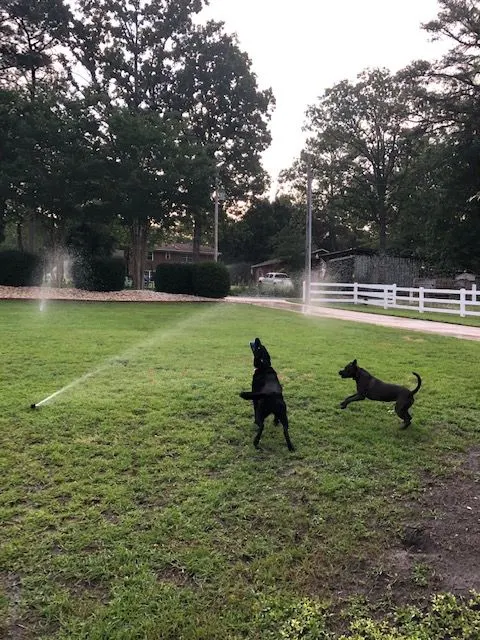
If you’re worried about annoying neighbors by letting your dog near their underground sprinkler systems or damaging your own, consider the alternative of setting up a portable lawn sprinkler in your own backyard.
They’re a minor investment and can be purchased for somewhere between $10-30 from Walmart, home improvement stores like Lowe’s and Home Depot, as well as from Amazon.
Tip: Involve the entire family by running, splishing and splashing in the sprinklers, and tossing toys around with your dog! It’ll be refreshing for everyone and it’s a great way to spend some quality bonding time together.
Set up a plastic kid pool for your dog.
Yet another idea is to buy your pup his own pool. We recommend a hard plastic version rather than a blow up pool since the latter can easily be deflated by a pup’s nails (been there, experienced that!).
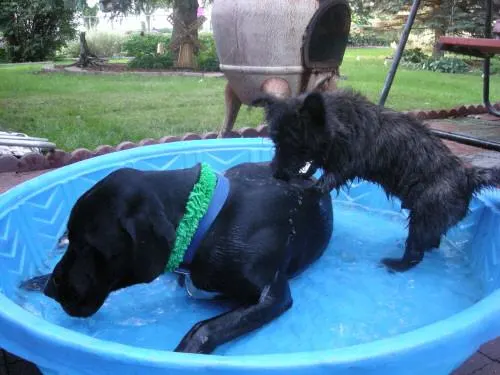
You can get a smaller one for as little as $8 at a Dollar General or similar store. Keep in mind that while this is the cheapest option, it might only last one season and only work well for smaller breeds.
Pools made specifically for dogs
You could also invest in a foldable pet pool. Ranging between $40-110, they’re more expensive than Dollar store pools, but a much more durable option as they’re specifically designed with roughhousing summer dogs in mind.
Let your dog bob for treats!
If your pup is not overly crazy about getting her paws wet, you could try introducing her to the concept of water fun with treat bobbing!
You can either toss some of her favorite treats into a pool, or start with a much smaller body of water like a water dish or a bucket.
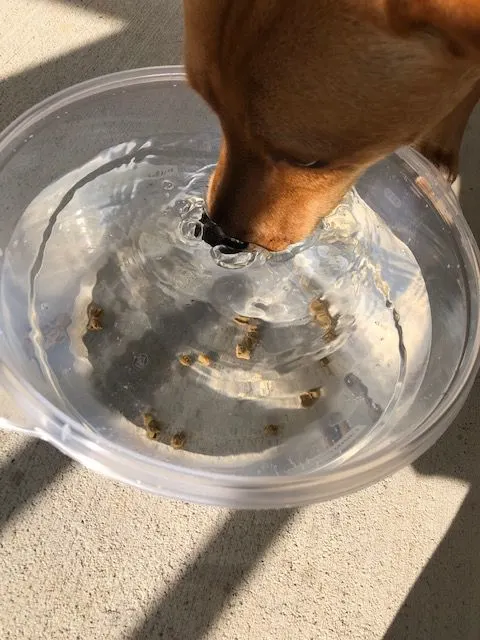
Most food-motivated dogs figure this game out very quickly and will have a blast fishing for their treats. If you have several dogs, you could turn this game into a little competition by setting a timer for a minute or however long you want and see how many treats each dog manages to bob for.
You may want to keep the pups separated with their own respective bowls or buckets to avoid potential food aggression!
Frozen food puzzle toys for dogs
Other rewarding games that don’t involve water but still focus on (frozen) edible goodies are food puzzles. You could fill a hollow dog toy with peanut butter, a pb/dry food mix, wet food or raw food, freeze it overnight, and then offer it to your dog the following day.
Depending on how long it takes him to figure out how to get to the food, it will keep him busy for a while and can also make a great form of crate entertainment.
Hollow dog toys we recommend for this type of game are natural rubber Kong toys since they’re durable and can easily be cleaned on the top dishwasher rack. Good alternatives are Nylabone’s stuffable chew toys.
Other interactive dog toys that dispense treats are the ones by Nina Ottosson:
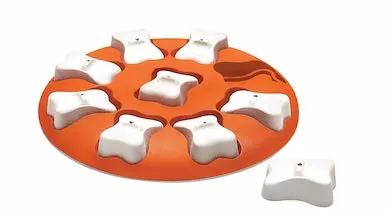
- Casino Dog Toy
- Smart Beginner Dog Puzzle
- Dog Twister
- Dog Tornado Puzzle
- Puzzle Brick Dog Toy
- Maze Dog Toy
They’re great boredom busters for hot summer days that need to be spent mostly indoors.
4. Visit pet friendly stores during a heatwave
What do you do when it’s blazing hot outside and your dog gives you that puppy eye look that says “please, please, I know it’s smoking hot outside, but can we go for a little adventure, pleaaaaase?”
Sometimes it’s truly too hot to take our dogs on outdoors adventures. Barbara lives in North Carolina where temperatures climb up into the mid and high 90s, sometimes even low 100s, during the summer months.
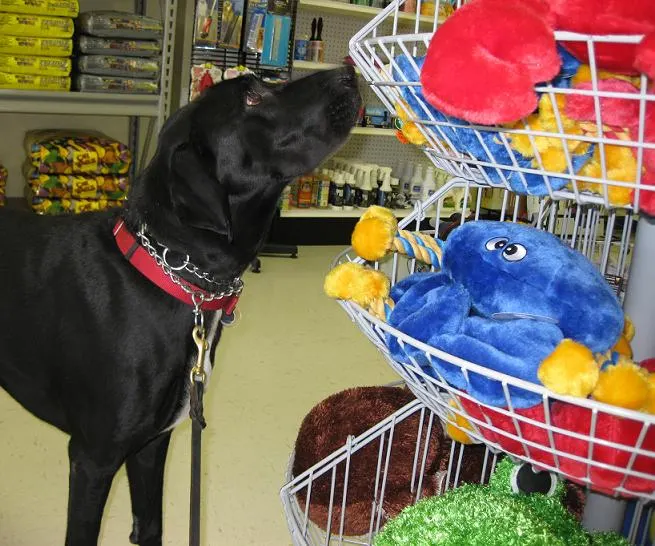
Combined with humidity, this type of weather can only be comfortably spent in cool water or an air conditioned environment.
However, days like these are perfect for a little air-conditioned car ride to an air-conditioned indoor shopping place that welcomes well-behaved, leashed dogs.
Indoor shopping with your dog is another great way of bonding with him while exposing him to new sights, smells, and sounds and practicing obedience.
Visiting pet stores like PetSmart
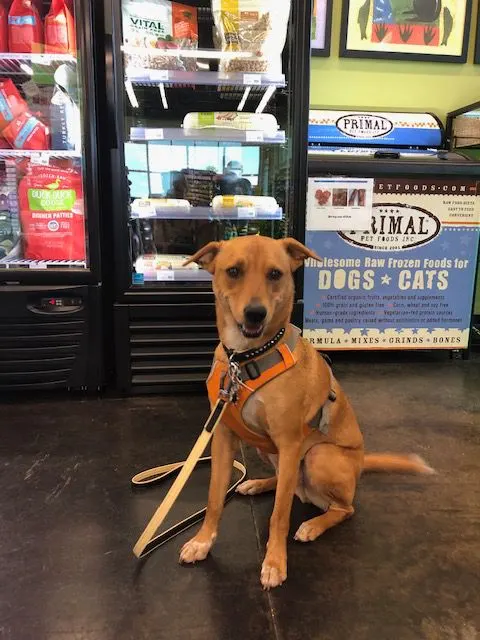
Walking down all the aisles with their toy and food distractions is an amazing exercise in impulse control and is therefore quite demanding on a mental level. As a result, you’ll have a tuckered out pup on your hands who’ll gladly settle in for a nap after the shopping experience!
Tip: If your dog is not overly crazy about going for car rides, we recommend checking out the car related sections in our 2 articles mentioned below. You’ll find practical tips on how to turn your dog into a confident canine passenger:
Barbara & her pup Wally like to head out to pet specific retailers like Petco, PetSmart and individually owned local ones in their Fort Bragg, NC area.
Whenever they’re store-bound, they like to practice:
- Sit-stays
- Down-stays
- Leave it
- Behaving politely and patiently when coming along to the human bathroom at the store
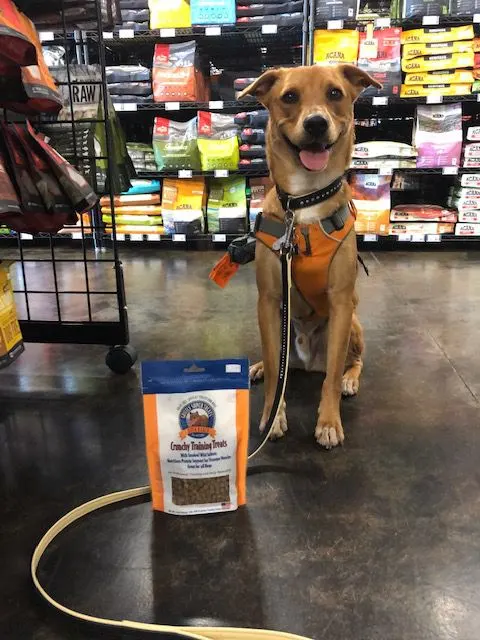
Overall, Wally has made a lot of shopping related training progress in the 4 months he’s been with Barbara. The first few times she took him to pet stores, he would kidnap squeaky plush toys and refuse to let go of them, meaning they ended up having to be paid for …
He’s now mostly able to walk past the plush toy aisle without doing some impromptu shopping, and he’s made progress with the “leave it” command. He still finds the open containers with treats and cookies very inviting, but now listens to Barbara’s “no, leave it” when he gets a little too close to them.
Visiting dog friendly human stores like Home Depot
Regular human stores that are also dog-friendly are another welcome shopping option to explore with your pup.
Many home improvement stores allow dogs such as:
- Lowes
- Home Depot
- and Tractor Supply
Your dog should of course be leashed and well-behaved, and you may want to double check on their individual policies before taking your dog.
Unless your dog is exceptionally well trained, it’s a good idea to walk him on a leash that will make it very easy to control any excitement related misbehavior.
We like and recommend 2 handle leashes or single handle leash tabs such as the ones from Mighty Paw. They truly come in very handy in higher traffic environments.
5. Make your dog frozen treats!
Frozen treats are the perfect way to give our pups some edible relief from the summer heat.
You can get really creative here since the sky’s the limit as far as ingredients are concerned.
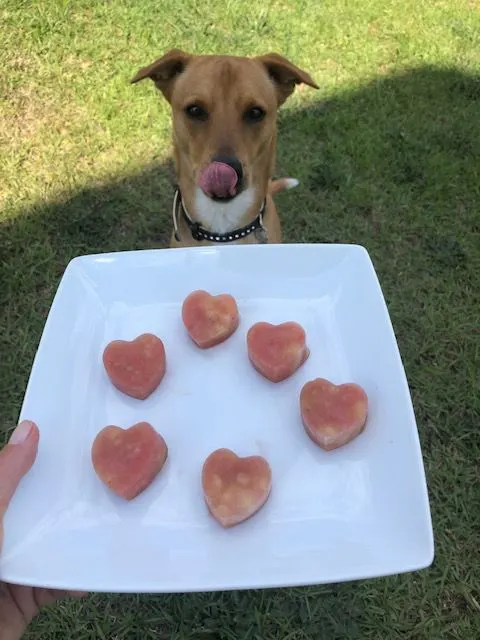
Just remember to cut back on your pup’s regular food intake or increase his exercise if you’ll be whipping up some frozen treats that are rich in calories.
The following 3 treat options have been a favorite with all of Barbara’s dogs (Missy, Buzz, & Wally):
Frozen bone broth treat recipe for dogs
Bone broth is a superfood that’s not only healthy, nutritious, and easily digestible for our dogs, but also for us humans.
It’s low in calories and particularly beneficial for aching joints and gut health.
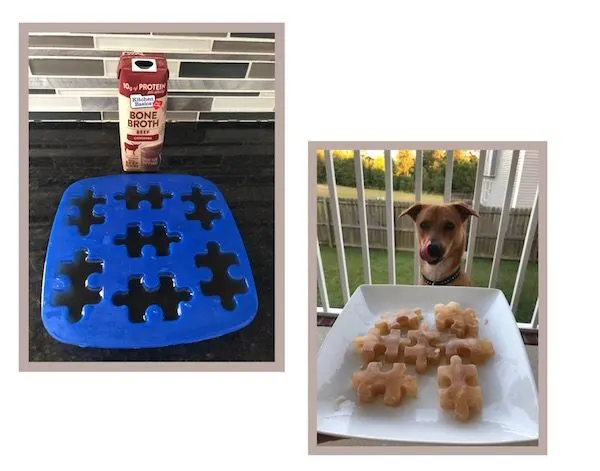
You can either use homemade bone broth or store bought bone broth.
Simply pour it into silicone ice cube or baking molds and freeze them overnight!
Frozen watermelon and banana treats for dogs recipe
Watermelon is a refreshing and nutritious summer fruit that’s low in calories. Bananas are great for heart health but contain a decent amount of fruit sugar, so combining both fruits makes for a yummy treat that’s still overall low in calories.

It’s best to use overly ripe bananas for this concoction because of how soft and easy to mash they are.
Simply mash the bananas and the watermelon up in a bowl and fill your favorite silicone molds with the mixture, then place in the freezer overnight.
2 overly ripe bananas and 2 cups of watermelon yielded Barbara’s dog Wally 28 frozen treats.
Frozen raw goat milk dog treat recipe
Raw goat milk is highly nourishing, reduces inflammation and is easily digestible because it’s low in milk sugars. However, it’s a calorie rich food and should be given in smaller quantities.
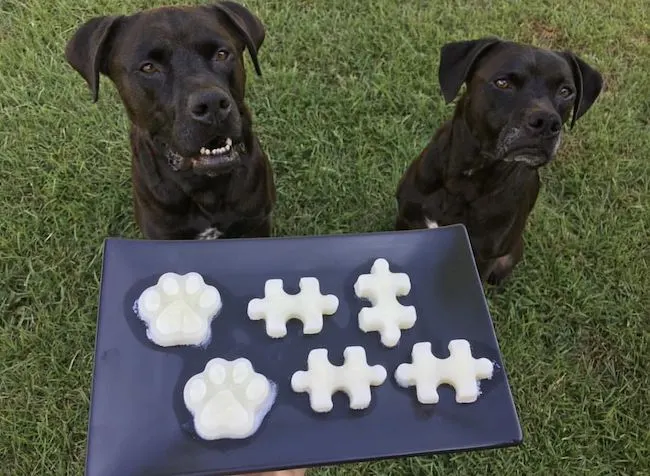
Simply pour the raw goat milk into your favorite silicone molds and place them in the freezer overnight.
You can buy the milk from brands like Primal Pooch, Raw Feeding Miami, and Raw Paws Pet Food.
If you have a frozen dog treat recipe, let us know in the comments!
6. Visit a dog friendly brewery or patio
Taking our dogs along to al fresco dining places or coffee shops is a fun activity because they get to come along with us, their humans!
That in itself should be celebration-worthy, but it’s also a great opportunity for socializing them to new locations, smells, other humans and possibly other dogs.
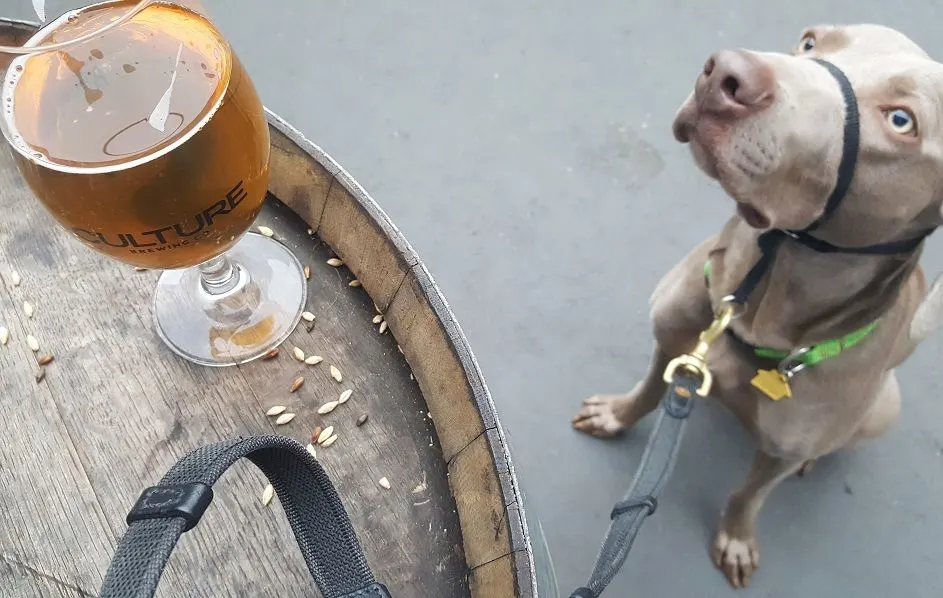
We’d like to point out that dogs of all ages benefit from ongoing socialization throughout their lives, but outings such as these are particularly helpful to get puppies comfortable and used to being in new environments.
See our post: Easy socialization tips for dogs and puppies
Try to avoid midday outings on days where the sun is blasting down on us mercilessly. We prefer taking our pups on cloudy summer days and early in the mornings or later in the evenings.
If you don’t know of any outdoor wining or dining establishments in your area, check out Bring Fido. It’s a great source of dog-friendly restaurants, coffee shops, and breweries that are searchable via geographic location. They also list dog-friendly hotels, activities, events, and services.
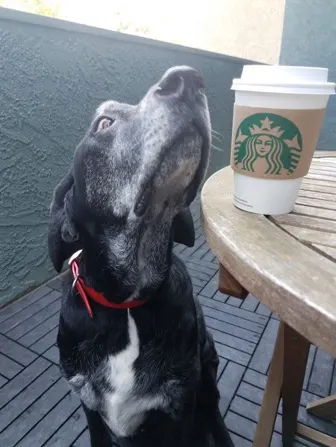
How to help your dog behave on an outdoor patio:
Exercise your dog beforehand.
If it’s too hot outside for a walk or run, try indoor exercises like hide & seek. They’re a great combination of physical and mental exercise.
Only take your dog along if he knows basic obedience.
Your dog should respond to the basics like sit, down and stay and he should be reasonably comfortable around people.
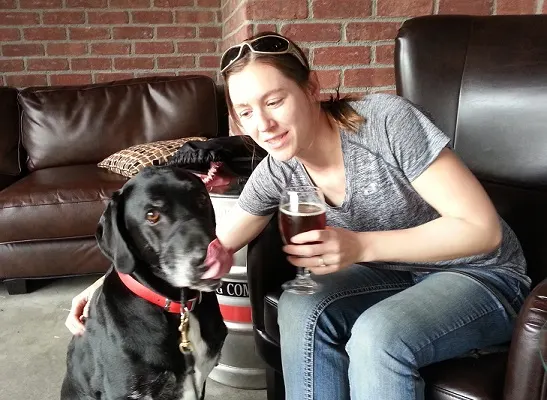
It will make the experience a pleasant one for everyone involved, including yourself, your dog, and other patrons. It’ll also ensure that your dog will continue to be a welcome canine guest!
Practice polite behavior ongoing.
Try to work with your dog on a daily basis and consider taking a basic obedience class with your pup. This will help him with future outings.
Gear for your dog at outdoor patios:
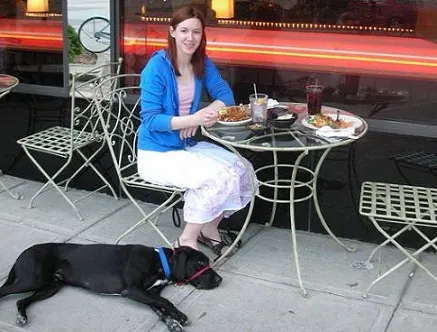
Multifunctional leash.
Those types of leashes come in very handy when you’re looking to secure your dog to a table or chair leg, tree, or similar structure.
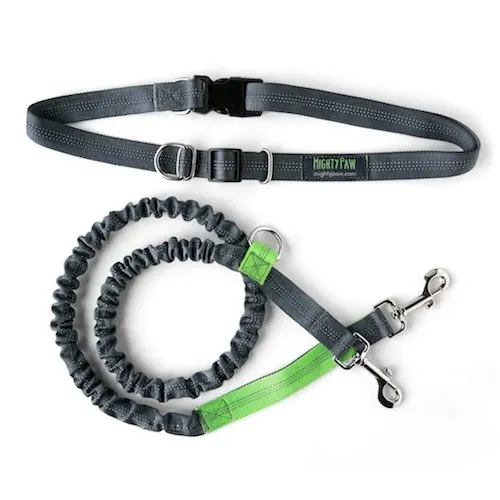
They typically come with several different attachment points or a buckle that opens to easily secure your dog. We recommend Mighty Paw’s Long Dog Leash (available in 15 and 30 ft length) or their 4-foot hands-free leash because both have options to attach the leash to poles or benches.
Collapsible dog bowl.
Many dog-friendly dining places feature water bowls for dogs, but it’s always a good idea to bring your own that you can keep right next to your dog.
Most collapsible water bowls come with a carabiner nowadays, which makes it convenient to attach to your dog’s leash or harness if he’s wearing one. Styles we like are Mr. Peanut’s collapsible pet bowl.
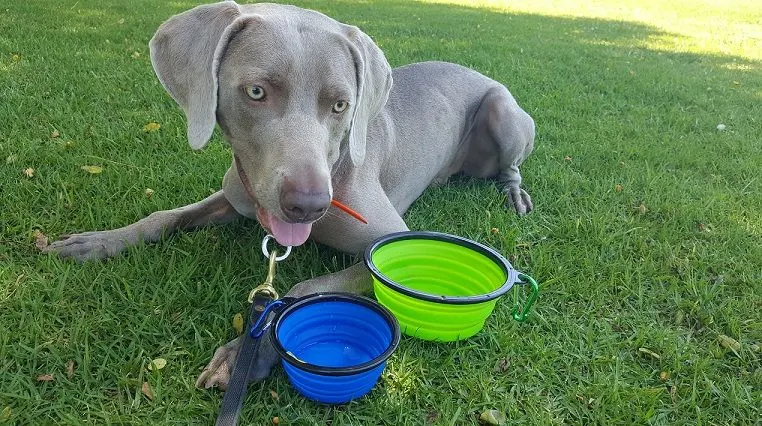
Dog chews.
A busy dog is a good dog, so set your pup up for success by entertaining him with a long lasting chew while you’re enjoying your food, drinks, and human conversation. Chews our pups enjoy are bully sticks and the occasional rawhide (only the non-bleached ones).
Dog cooling mat.
If the place you’re taking your dog to has floors that heat up quickly and retain the heat, a cooling mat can be helpful in keeping your dog comfortable in an extended down position.
He should be fine without a cooling mat on stone, tile, concrete, or grass. Cooling mats can be purchased at PetCo and PetSmart or Amazon.
Small training treats
This is so you can reward good behavior like extended down-stays. Training treats we recommend are Vital Essentials’ freeze dried line of single-ingredient treats, Campfire Treats and Grizzly’s Training Treats. You can also simply cut up hotdogs and/or cheese into tiny bites and bring those along. A treat bag also helps.
If your dog is a little on the shy side, check out our tips for shy dogs in public at the end of this article.
7. Take your dog to a sporting event or other public event
Summer is a time for sports, festivals, special events and numerous other activities, some of which you can share with your dog. Check online to see what’s happening in your community and whether dogs are welcome. Bring Fido is another source to find dog friendly activities.
Baseball game with your dog
One unique experience to consider is a baseball game. Several Major League Baseball teams offer specific dog-friendly games during their regular seasons (the AKC has a round-up of dog friendly MLB games or check your team’s schedule).
Attending festivals and other events with your dog
A lot of the tips for dining out with your dog (above) apply to sports and other festivals.
These events tend to be busy with lots of action and lots of people. If you’re considering bringing your dog on a special outing, your dog should have excellent leash skills and be well-socialized. (And if your dog is more reserved, check out our tips for public outings for shy dogs below).
Choose events that your dog will actually like.
Think about the type of activities that are part of the event you’re attending. A fair with spinning rides, noisy games and excited children is a different experience than an evening at an outdoor concert.
Be real about whether the event is fun for your dog and consider whether your dog will be happier at home.
During the event keep an eye on your dog and your surroundings. Make sure that he’s not anxious or over-stimulated. Be prepared to move where you’re sitting (if your ticket isn’t for a specific seat) or leave early if necessary.
Watch for food on the ground.
Food is a big part of most summer events. Hotdogs get dropped, ice cream scoops fall off their cones, or a picnic gets laid out on the grass. Watch your dog carefully to make sure he doesn’t eat extra food or anything unsafe.
If your dog is particularly food motivated, you may have to be very diligent. Practice the “leave it” command in a calm environment, like your home, before putting your training to the test at a special event.
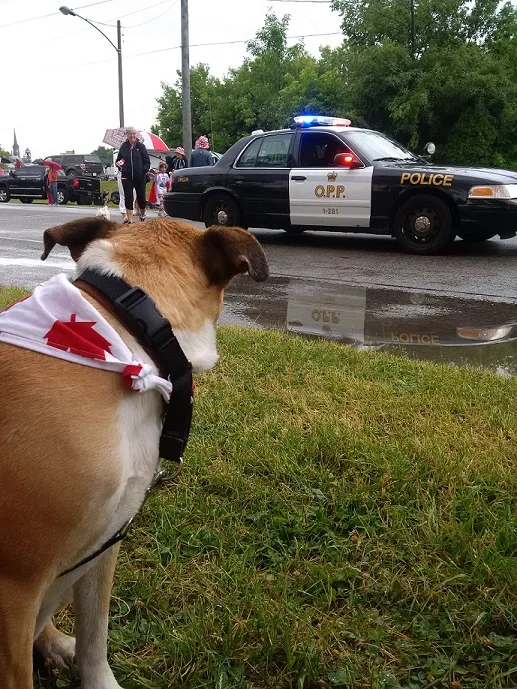
Be aware of your dog’s surroundings.
Dogs attract attention! Children, adults and other dogs may all want to meet your dog. Even the most well-socialized dog can become overwhelmed or over-excited by the extra attention.
Your dog may also be surprised by someone coming up to pet him. In a crowd he may be bumped or stepped on. Stay tuned in to your dog and your surroundings so that you can keep your dog comfortable and safe.
Know your dog’s body language and give him a break if he needs it, either by telling visitors not to pet him or by seeking out a quieter spot for a few minutes. Project calm energy yourself and manage the situation to ensure your dog enjoys your outing.
8. Summer hiking with your dog
Hiking is a great year-round activity, but it becomes even more enjoyable in the summer. On a hot day, the woods can be cooler than the sidewalk and the experience of a hike can add variety to your walk routine.
Off-leash hiking tips
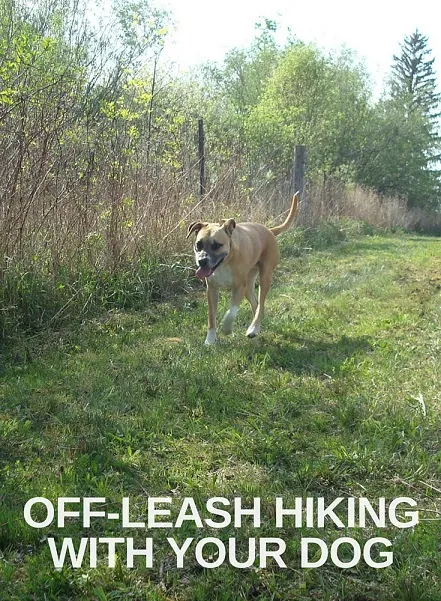
Julia loves off leash hiking with Baxter and she has shared some of her tips for training your dog for off leash hiking in previous posts:
- How to Train A Dog to Be Off Leash
- 15 Tips for Off Leash Hiking With Your Dog
- How Leash Dragging Prepares Your Dog to Go Off-Leash
Hiking with your dog on a leash
On leash hiking can be equally rewarding and it’s usually easier to find trails if you plan to keep your dog on leash.
Hiking can also be a great activity for shy dogs who aren’t interested in patio dining, baseball games or summer festivals. Find a quiet trail where you’ll won’t run into other dogs, or go early in the day to ensure you’ll be alone.
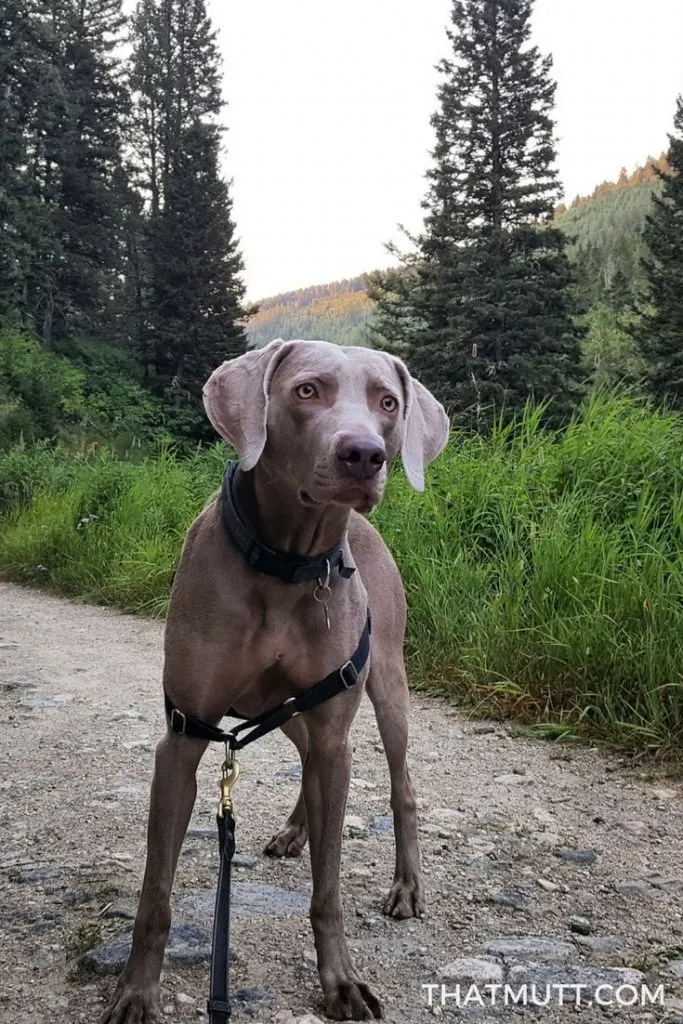
Tips for summer hiking with your dog:
- Seek out different trails or hiking partners.
- Hike early in the day before it gets too hot.
- Choose a route with water (ponds or creeks) so that your dog can cool off with a drink or a swim or carry water for yourself and your dog.
- Obey leash laws.
- Know basic first aid to treat your dog for cuts, sprains or over-heating.
- Protect yourself and your dog from ticks and other bugs.
- Consider putting a bear bell on your dog to alert bikers, other dogs and wild animals
9. Camping with your dog
Camping can be a great activity to do with your dog. Spending time together as a family. Sharing special experiences. All day in the great outdoors. We think most dogs will be saying, “When do we go?”
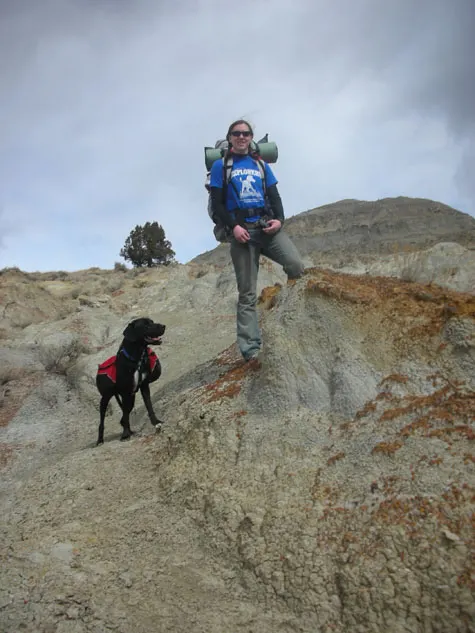
Obviously, the first step is to start with a dog-friendly campground. Not every camp allows dogs, so check before you pack up the tent or rev up the RV. Dog friendly also means the area and activities. Select a campground with hikes, attractions or amenities that your dog will enjoy.
When planning what gear to bring, think about what your dog needs to be comfortable. You may have to select a bigger tent so that your dog has a spot to sleep.
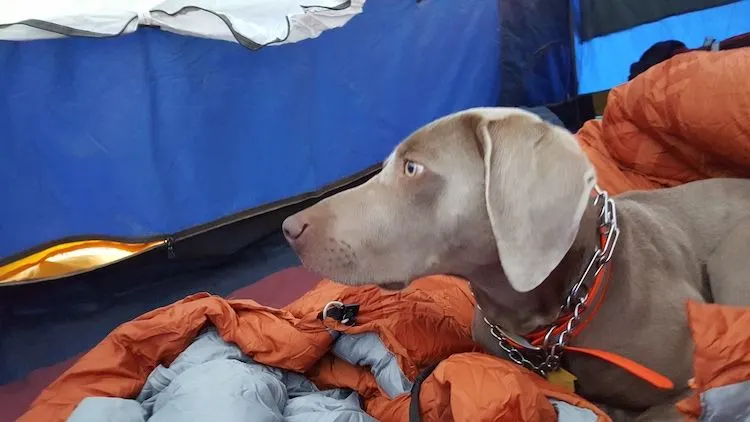
If your dog regularly sleeps in a bed or crate, bring those with you. You may also want to bring a cot or blanket so your dog can lay comfortably outside. Practice setting up the tent at home first so that your dog can get used to it before your trip.
A benefit of camping is that you’re usually cooking your own meals at your campsite, so you don’t have to worry about finding dog-friendly restaurants. Make sure to bring enough food, water and all of the necessary bowls for your dog.
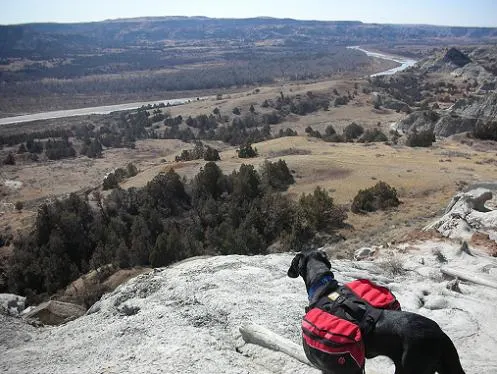
Most campgrounds have leash laws. A long leash and a sturdy stake or tie-out will keep your dog safe and secure. Do not leave your dog tied up at your site when you’re not there. Likewise, don’t leave him in the tent or the car. If you’re camping with your dog, be prepared to be with your dog.
Weather is a reality of camping. While humans can sit in the tent or RV and play cards during a rainy day, your dog will likely not be entertained with another game of Go Fish. Be prepared to be out with your dog, no matter the weather. Pack raincoats, warm clothes, extra footwear or whatever you need to be comfortable, no matter what is happening outside.
See our tips: Camping with dogs
10. Family vacation with your dog
On a family vacation, most of us want all of our family with us, including our dogs. Ensuring a fun and relaxing vacation for all family members starts at the planning stage.
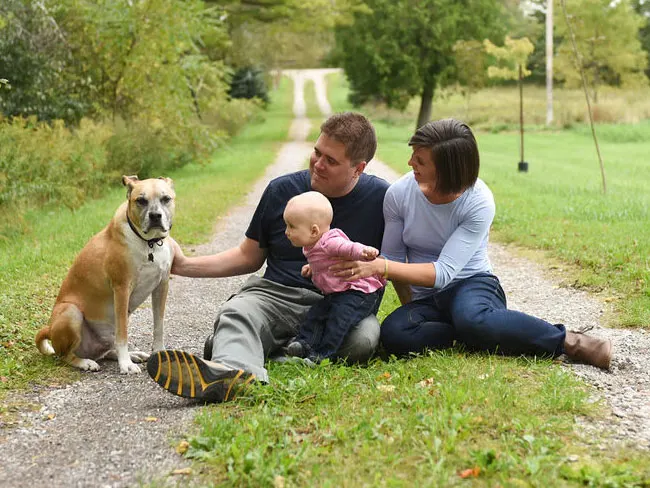
Think about the things you and your dog like to do together. If your dog loves to swim, perhaps a cottage with a lake and beach will be the best fit for your family.
If you enjoy solitary hikes in the woods, a secluded cabin could be a great option. Or if you like a variety of experiences, perhaps visiting a new city could be a great fit.
Once you’ve figured out the basics of where you want to go, it’s time to get to the specifics.

Choose dog-friendly accommodations.
Most often this means a home or cabin as opposed to a hotel, unless you’re staying with friends or family. Bring Fido, GoPetFriendly.com or AirBNB are all helpful resources to find a place to stay.
Being able to prepare your own meals means that you don’t have to find a dog friendly restaurant for every meal. As well, you can prepare food in advance and pack a picnic lunch to eat on the go. A house, even a small one, also gives you more space and is more similar to the environment your dog is used to.
If you end up staying in a hotel with your dog, we have some tips here on how to help your dog feel calm in a hotel.
Plan activities in advance.
Before you go on vacation, figure out what dog-friendly facilities and activities are available in the area you’re traveling to. You don’t want to spend your vacation searching on your phone to figure out what you’re going to do today.
Bring the essentials… and a few comforts of home.
Bring food and chews, bowls, medications, leashes and tie-outs, crate or bed, toys–whatever it takes to make your dog feel comfortable in his home away from home. And don’t hesitate to bring extras in case something gets lost or breaks during the journey.
Prepare for emergency.
While vacations are supposed to be relaxing, things can go wrong. Before you leave home, make sure your dog’s microchip and tags are up-to-date. Putting your cell number on your dog’s tag ensures you can be reached no matter where you are. Bring a basic first-aid kit and know how to treat common ailments.
Also, when you’re planning your vacation take the time in advance to find a vet in the area that you’ll be travelling to. Having the phone number close at hand if you need it can save time and stress. Have a list of any medications your dog is on or consider bringing an electronic copy of your dog’s medical records.
Travel in comfort.
While stay-cations can be relaxing, most vacations involve some travel. If you’re driving, keep your dog safe and comfortable with a harness or crate. Baxter usually rides in his dog bed in the back of Julia’s car.
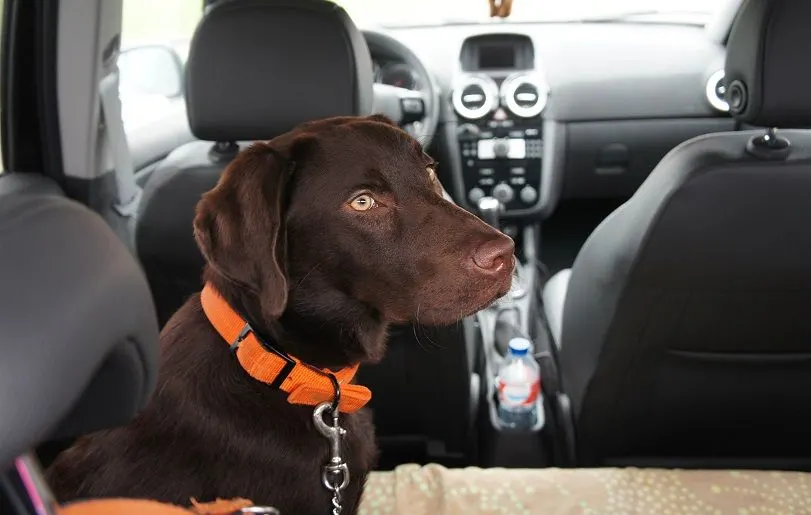
Vacations may mean that your car is tightly packed with extra gear. Make sure your dog is not crowded. If you’re driving a long way, plan on some pit stops to let your dog stretch his legs, burn off energy and take a bathroom break.
If you’re flying to your destination, check with your airline in advance for specific regulations that apply to your dog. Help your dog be as calm as possible on travel day with extra exercise or consider medication if he’s particularly anxious (talk to your vet well in advance for advice).
See our posts:
Relax.
Vacations are meant to be relaxing. Even if you’re a very active family with a high-energy dog, everyone benefits from downtime. Don’t fill every second of your time away from home with activities.
As well, be flexible. The change in environment and routine may cause a bit of stress or anxiety for your dog. Give him some time to adjust.
The weather, personalities and moods can all affect what you feel like doing on a given day. Adapt and have fun with each other. You’re on vacation!
General tips for helping shy dogs in public
Since so much of this article is about getting out and about with your dog, we wanted to share some tips on how to help shy dogs in public.
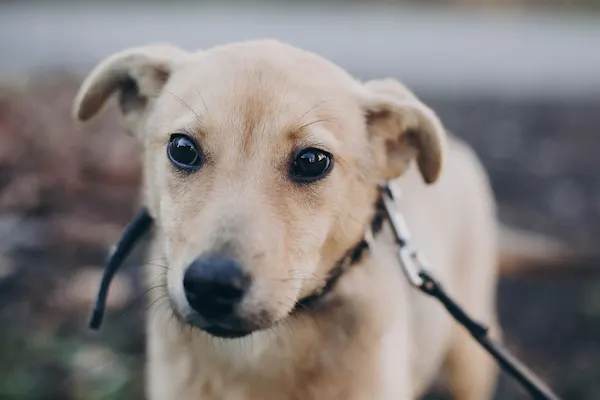
Shy dogs are usually those who weren’t properly socialized as puppies or haven’t been exposed to ongoing socialization throughout their adult lives.
It’s important to understand that it’ll take some time to introduce them to everything they’ve missed out on so far that will end up boosting their confidence.
With that understanding in mind, our number one tip for helping shy dogs in public is to take things slowly and not rush your dog into interactions with fellow dogs and other people.
It’s ok if she’s not crazy about meeting new dogs or people right away. You can keep your distance for a few weeks or even months to give her a sense of what’s out there, and then slowly decrease the distance between you and other people and fellow dogs.
Plenty of space and boundaries
While your dog is working on building that confidence in public, make sure she gets plenty of space, especially if she’s a smaller breed. People you encounter in public tend to be more drawn to “cute” little dogs and are more likely to shy away from wanting to touch and pet larger breeds than smaller ones.
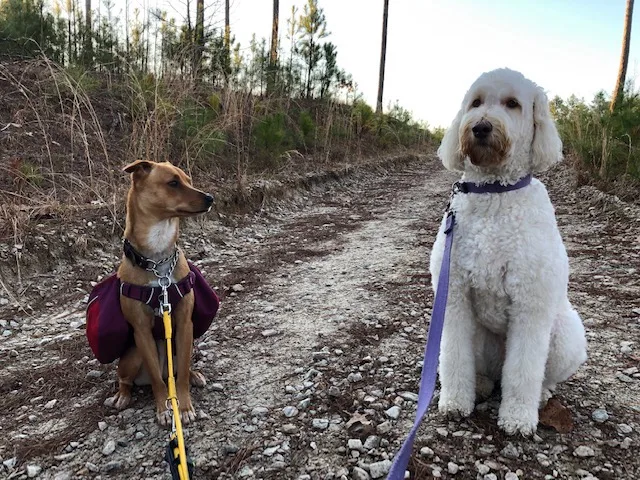
Tell people to stay back
There are of course those people who consider themselves dog fanatics who’ll be all up in any dog’s face (literally!), regardless of breed.
To avoid those scenarios, consider investing in accessories that send clear messages to anyone you encounter while out and about – give my dog space and do not pet him, he’s in training!
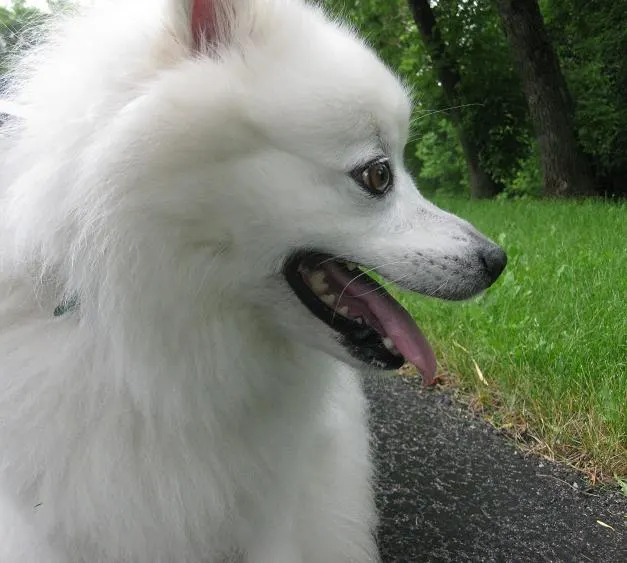
This could be a harness that comes with “In Training” or “Do not pet” patches, individual patches that can be attached to a harness or leash your dog already uses, or a leash with similar wording.
In addition to those accessories, don’t be afraid to tell people and kids alike to please not touch and/or come near your dog, even if they insist. Be polite but firm in your request. You could say something like “My dog is afraid, please don’t touch him” or “Please respect my dog’s space.”
See our posts:
Move away from the situation
If all else fails, simply walk away from persistent people, even if it means walking on the other side of the street, or turning around and walking the other way. Don’t worry about coming off as rude. After all, you have your dog’s best interest at heart and don’t want to be responsible for a bite caused by the fear of a stranger’s hand.
For more details on how to help your anxious dog, we have written a much more in-depth article: How to help my anxious dog.
Now we’d like to hear from the rest of you!
What activities do you do with your dog in the summer?
Let us know in the comments!
Julia Preston is a blogger at Home on 129 Acres where she writes about her adventures of country living and DIY renovating. She and her family live on a 129-acre farm in Ontario, Canada.
Barbara Rivers writes regularly for That Mutt. She is certified in raw dog food nutrition from Dogs Naturally Magazine and the author of three ebooks about balanced raw dog food. She is a blogger at K9s Over Coffee.

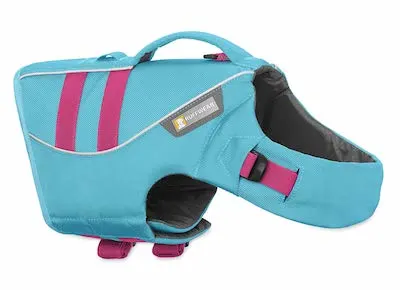
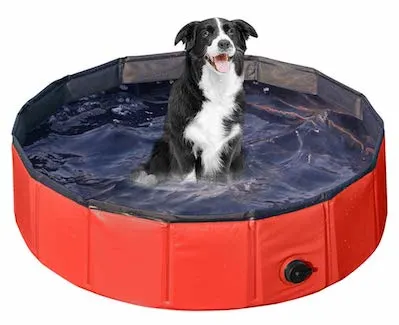
Ashley Williams
Thursday 11th of July 2019
I enjoyed reading your blog as it answered my every question. My husband is into the army, so we hardly go for family vacations. But, I wanted to go camping with my buddy, and this blog was quite useful to prepare myself for that. Thank you, Julia.
Saber
Sunday 23rd of June 2019
My dog Saber loves the beach. He would spend day and night on the beach and swimming in the sea if he could..
Julia T.
Friday 19th of July 2019
It's great that you've found something that your dog loves so much.
anthony
Thursday 20th of June 2019
Super cool ideas!!!
Julia at Home on 129 Acres
Friday 21st of June 2019
Thanks. Let us know if you try any of them out.
Carol North
Thursday 13th of June 2019
Really enjoyed this article! My web-footed Weimaraner, Gator, was terrified of water - baths, swimming pool, and ocean. But my Schnauzer loved the beach, so thanks for this piece. I know Murphy would enjoy it, and I'll make an effort to take him to the dog beach.
Lindsay Stordahl
Friday 14th of June 2019
Haha, my weim is not a big fan of water either. He'll wade in shallow ponds and streams but doesn't like to swim. He's a big baby.